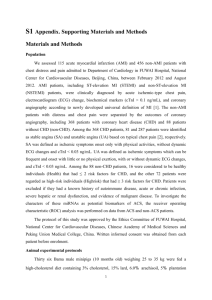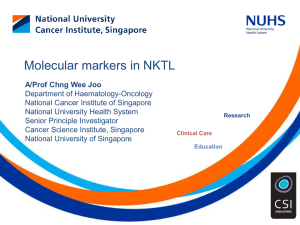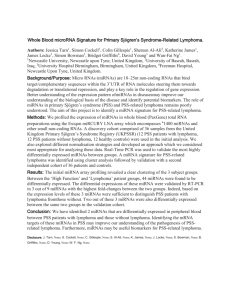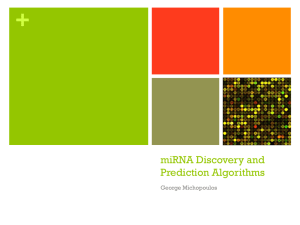Artemisia absinthium (AA) modifies the expression profile of
advertisement
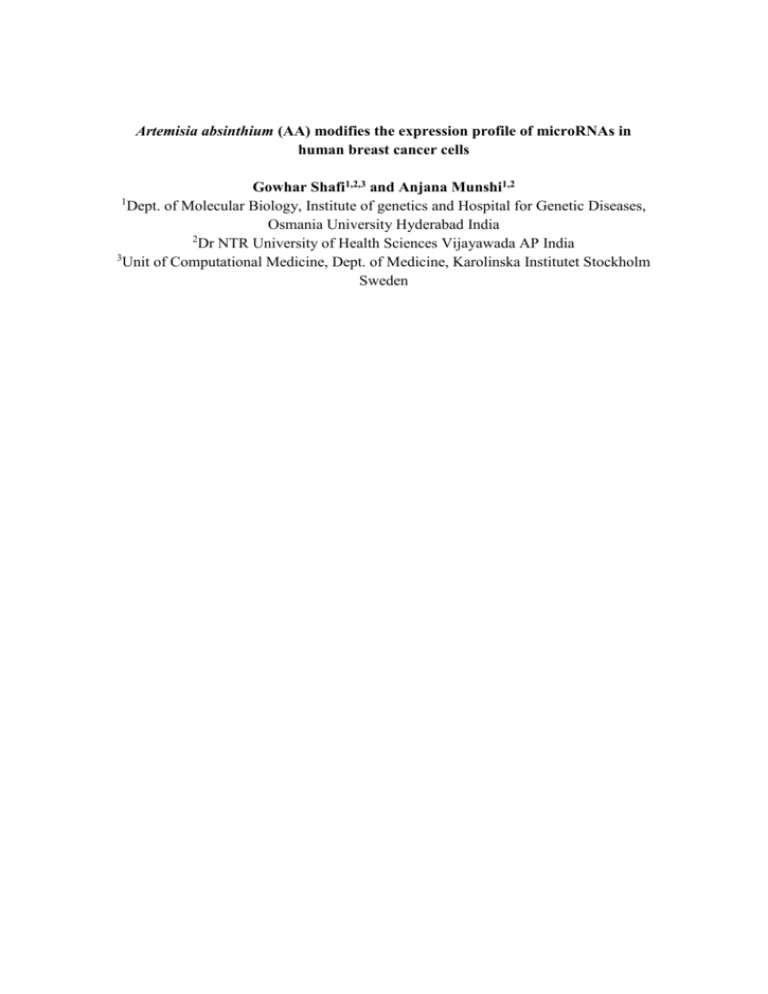
Artemisia absinthium (AA) modifies the expression profile of microRNAs in human breast cancer cells Gowhar Shafi1,2,3 and Anjana Munshi1,2 1 Dept. of Molecular Biology, Institute of genetics and Hospital for Genetic Diseases, Osmania University Hyderabad India 2 Dr NTR University of Health Sciences Vijayawada AP India 3 Unit of Computational Medicine, Dept. of Medicine, Karolinska Institutet Stockholm Sweden Abstract Increasing evidences in recent years reveal that several biological processes and disease pathogenesis are regulated by microRNAs (miRNAs) and restoration of normal miRNA activity can be novel way of treating cancers. Side effects of conventional chemotherapeutic drugs are well known. Therefore, from therapeutic point of view, the best strategy is to induce apoptosis in cancer cells without affecting the normal cells of the body. In this context, phytochemicals are a potential alternative source of safer chemicals and have several other physiological synergistic benefits. In this study we determined if the methanolic extract of Artemisia absinthium (AA) could modify the expression pattern of miRNAs. Microarray analysis was used to profile miRNA expressions in human MCF-7 and MDA-MB-231 breast cancer cells treated with AA. Transcripts with regulated expression patterns on the microarrays were validated by SYBR Green based real time PCR. AA modifies miRNA expression in human MCF-7 and MDA-MB-231 breast cancer cells. It up-regulates miRNA-22 and down-regulate miRNA-199a*, as confirmed by SYBR Green Realtime PCR. These observations suggest that modulation of miRNA expression might be an important mechanism underlying the biological effects of AA in containing cancer. Results also suggest that these miRNAs might be the future therapeutic agents in breast cancer with lesser side effects. Keywords: Artemisia absinthium, MicroRNA, Cancer, Chemotherapy Introduction The chemotherapeutic agents long used in oncologic treatment produce deleterious side effects that augment the mortality and morbidity caused by cancer. Safer treatments are thus desperately needed, some of which can be found in natural compounds such as phytochemicals. Although chemopreventive activities and preclinical antitumor effects are established, phytochemicals provide a novel therapeutic approach that merits further exploration. Artemisia absinthium (AA) is commonly called wormwood and is locally known as ‘Tethwen’ in Kashmir valley, India. It is used in indigenous system of medicine as a vermifuge, an insecticide, an antispasmodic, an antiseptic and in the treatment of chronic fevers and for inflammation of the liver [Koul 1997]. Its essential oil has antimicrobial [Juteau et al 2003] and antifungal activity [Saban et al 2005]. Chemical analysis of AA plant has shown that its volatile oil is rich in thujone, which has been earlier reported as an anthelmintic [Meschler and Howlett 1999]. In Turkish folk medicine, AA has been used as an antipyretic, antiseptic, anthelmintic, tonic, and diuretic and for the treatment of stomach aches [Baytop 1984]. miRNAs are tiny (19–23 nucleotide) non-coding RNA molecules that are currently being recognized as endogenous physiological regulators of gene expression. These small RNAs are capable of controlling gene expression either by repression of translation/transcription [Bartel 2009] or by activation of transcription [Li 2008]. miRNAs are also known to play important roles in many physiological and pathological processes, including tumorigenesis [Mocellin et al 2009], proliferation [Johnnidis et al 2008], hematopoiesis [Merkerova et al 2008], metabolism [Aumiller and Forstemann 2008], immune function [Carissimi et al 2009], epigenetics and neurodegenerative diseases [Shafi et al 2010, Bushati and Cohen 2008]. miRNAs have also been found to be useful in identifying the etiology of lymphoma [Lawrie et al 2007] and progression of certain neurological diseases [Nelson et al 2008]. We hypothesize the therapeutic mechanisms of AA could rely, at least in part, on their influence on miRNA expression. If such an association is confirmed, it might provide a potential opportunity for miRNAs acting as novel targets for treatment by interference and biomarkers for selection of chemotherapeutic agents. To test this hypothesis, we used microarray analysis to identify the differential expression profiles of miRNA in MCF-7 and MDA-MB-231 breast cancer cells following exposure to the AA. Microarray data was confirmed by Real Time PCR analysis. Methods Preparation of Plant Material Plant was selected on the basis of ethnopharmacology and 1/2 Kg of plant material was collected locally. It was identified by botanist, Department of Botany, Osmania University, where a voucher specimen is deposited at Department of Botany herbarium. The aerial parts of AA were air dried in shade then powdered using a milling machine. The powdered plant material was extracted with methanol as described previously [Shafi et al 2009]. Briefly, powdered plant material was soaked into methanol for extraction. The quantity of methanol was taken 10 times the quantity of plant material. Extraction was performed three times and each extraction was done for 24 h. Methanolic filtrate was then evaporated under reduced pressure to obtain a residue (500g of AA yielded 29.15g of residue). The residue was dried using a rotary evaporator to obtain the powder/paste. The required quantity of the dry powder/paste was dissolved in dimethyl sulfoxide (DMSO). Preparation of drug A stock of plant extract was prepared with concentration of 1mg/mL of DMSO and sterilized by autoclaving at 121°C and 15 lb for 15 min. Then stock concentrations of test compound were prepared by diluting stock with DMEM. Maintenance of Cell culture MDA-MB-231 and MCF-7 cells were procured from National Centre for Cell Science (Pune, India). The cell lines were maintained and propagated in 90% Dulbecco's Modified Eagle's Medium (DMEM) containing 10% fetal bovine serum (FBS) and 1% penicillin/streptomycin. Cells were cultured as adherent monolayers (i.e., cultured at approximately 70% to 80% confluence) and maintained at 37°C in a humidified atmosphere of 5% CO2. Cells were harvested after brief trypsinization. All chemicals used were of research grade. Extraction of Micro RNA Total RNA including small RNA was extracted from the both cell lines using RNA isolation kit (Qiagen, Hilden, Germany) as per the instructions of manufacturer. The concentration of RNA was quantified by a NanoDrop ND-1000 Spectrophotometer (Thermo Fisher Scientific, U.S.A). The quality of RNAs was determined using 2% agarose gel. Microarray analysis MiRNA expression was investigated using the Agilent Human miRNA microarray v.2 (#G4470B; Agilent Technologies, Santa Clara, CA, USA). This microarray consists of 60-mer DNA probes synthesized in situ and contains 15000 features which represent 923 human miRNAs, sourced from the Sanger miRBASE database (Release 14.1). RNA labelling and hybridization were performed in accordance with the manufacturer’s instructions. An Agilent scanner and Feature Extraction 10.5 software (Agilent Technologies) were used to obtain the microarray raw data. cDNA Synthesis from MicroRNA Quantitation of miRNAs was carried out using SYBR Green PCR. Briefly, 100 ng of template RNA was reverse transcribed in 20µL using universal stem-loop primer (Qiagen, Hilden, Germany). For the PCR reaction, 20ng of RT-product was used. MicroRNA quantification SYBR green qRT-PCR assay was used for miRNA quantification. One microgram of total RNA was polyadenylated and reverse transcribed to cDNA using miScript Reverse Transcription kit (Qiagen). Quantitative PCR assays were carried out in ABI PRISM 7500 Fast real-time PCR system (Applied Biosystems) using miScript SYBR Green PCR kit (Qiagen). Each reaction was performed in a final volume of 20µL containing 2 µL of the cDNA, 0.5 mM of each primer and 1x QuantiTect SYBR Green PCR Master mix (Qiagen). The amplification profile was denaturation at 950C for 15 min, followed by 40 cycles of 940 C for 15 s, 550 C for 30 s, and 700C for 30 s. At the end of the PCR cycles, melting curve analyses were performed as well as electrophoresis of the products on 2% agarose gels in order to validate the specific generation of the expected PCR product. The expression levels of miRNAs were normalized to RNU1A. Statistical analysis Microarray results were analysed by using GeneSpring GX 11 software (Agilent Technologies). Data transformation was applied to set all the negative raw values at 1.0, followed by quantile normalization and a log2 transformation. Filters on gene expression were used to keep only the miRNAs expressed in at least one sample. A 1.5 fold-change filter and ANOVA (analysis of variance) statistical test were applied. Differentially expressed genes were employed in cluster analysis, using the Manhattan correlation as a measure of similarity. The statistical analyses were performed using the SPSS software package, version 18.0 (SPSS Inc. Chicago, IL, USA). The cycle threshold (Ct) value for the genes was determined by SDS software v1.2 (Applied Biosystems, Foster City, CA). Ct is the threshold cycle, the cycle number at which fluorescence is generated in a reaction crossing the threshold. The expression level of miRNA was normalized by calculating the ΔCt value based on subtracting its Ct value from that of the internal control RNU1A. The relative gene expression was calculated as 2−ΔCt. The amplitude of change of the expression miRNA observed in patients in relation to control group was analyzed by the 2−ΔΔCt method [Livak and Schmittgen 2001]. Statistical significance was measured using Student's t-test, difference was considered significant at P < 0.05. Resuts AA Treatment Modifies miRNA Expression Profiles To study the responses of miRNAs to AA, microarray analysis of miRNA expression was conducted with miRNA-enriched total RNAs extracted from both cell lines treated with respective IC50 concentration of AA (data not shown). RNA samples were processed, labelled, and hybridized to Agilent miRNA chips as described in Methods. Figure 1 and 2 show the effects of AA on miRNA expression in MCF-7 and MDA-MB-231 breast cancer cells. After 48-h incubation, 11 miRNAs were significantly upregulated, whereas 18 were significantly down-regulated in MCF-7 by AA compared with untreated cells (Fig. 1). Among these miRNAs, miRNA-22 was upregulated by 65.5%, whereas miRNA-199a* was downregulated by 54.2%. Similarly, in MDA-MB-231 at the IC50 concentration, AA significantly up-regulated the expression of 5 miRNAs and down-regulated 10 miRNAs (Fig. 2). AA enhanced miRNA-22 expression (68%) but decreased miRNA-199a* expression (71%). A greater number of miRNAs were down-regulated than up-regulated in both cases. Interestingly, miRNA-22 was up-regulated and miRNA-199a* was down-regulated consistently and substantially in both cell lines by AA. Differentially Expressed miRNAs by Real-time PCR Quantitative Real Time PCR was done for the two miRNAs, miRNA-22 and miRNA199a*, which were up-regulated and down-regulated, respectively, in both cell lines by AA treatment in the microarray experiments (Fig. 3A). miRNA-enriched total RNAs from the same preparation used for microarray analysis were reversetranscribed and amplified in the ABI Prism 7500 Sequence Detection System for SYBR Green analysis. As shown in Fig. 3B, miRNA-22 was up-regulated by AA treatment in both MCF-7 and MDA-MB-231 breast cancer cells by 60.3% and 68.6%, respectively (Fig. 3B), whereas miRNA-199a* was down-regulated by 25.1% and 36.40% (Fig. 3C), respectively. The results obtained by quantitative real-time PCRs were comparable with and confirmed the microarray data (Fig. 3A). Discussion Several recent studies have demonstrated that various chemical compounds induce differential expression of miRNAs in a variety of animals and animal cell lines (Marsit, Eddy et al. 2006; Saito, Liang et al. 2006; Moffat, Boutros et al. 2007; Pogribny, Tryndyak et al. 2007; Rossi, Bonmassar et al. 2007; Blower, Chung et al. 2008; Sun, Estrov et al. 2008; Zhang and Pan 2009). These chemicals include anticancer drugs as well as environmental toxicants. However, there are no studies on the effect of natural products on expression pattern of miRNA in in vivo or in vitro. In this study, we report, for the first time, the global expression profile of miRNAs in human MCF-7 and MDA-MB-231 breast cancer cells and the effect on the miRNA expression profile after 48 hours of treatment with AA extract. Based on our microarray analysis with 923 currently known human miRNAs, 29 and 15 miRNAs were identified to have differential expression after AA treatment in MCF-7 and MDA-MB-231 respectively. Although some of the differentially expressed miRNAs, have been reported previously to have differential expression in response to chemical treatment in human cell lines or animal models. However, majority of the AA-regulated miRNAs observed in the present study have not been reported in previous studies. Therefore, it seems that these miRNAs uniquely respond to AA treatment. Our microarray experiments showed that AA up-regulated the expression of some miRNAs (such as miRNA-22) while as down-regulated others (such as miRNA- 199a*). Real-time PCR experiments with miRNA-22 and miRNA199a* further confirmed the expression patterns we found in our microarray experiments. The results of our investigations and others suggest that the spectrum of miRNAs that respond to drug treatment is unique to specific groups of drugs. Investigating the molecular regulatory mechanism of the common and drug-specific miRNAs will allow us to better understand the therapeutic efficacy of different drugs thereby provide new insight on screening new drugs for cancer treatment. In conclusion, we used microarray technology to analyse the expression of all known human miRNAs following treatment with AA. Two AA-responsive miRNAs; miRNA-22 and miRNA- 199a*, showed major and consistent effects, which were validated by microarray analysis and real-time PCR. Therefore, we suggest that AA extract has anti-cancer effect that is mediated via regulating the expression of specific microRNAs in human breast cancer cell lines. Further, manipulating the expression of miRNA may modify the protein expression of its target genes. This suggests an important and novel mechanism by which AA mediates its potent effects on cancer cell proliferation. References Aumiller V, Forstemann K (2008) Roles of microRNAs beyond development– metabolism and neural plasticity. Biochim Biophys Acta 1779(11): 692–6. Bartel DP (2009) MicroRNAs: target recognition and regulatory functions. Cell 136(2): 215–33. Baytop, Therapy with Medicinal Plants in Turkey, Istanbul University Press, Istanbul, Turkey (1984) 166–167. Blower, P. E., J. H. Chung, et al. (2008). "MicroRNAs modulate the chemosensitivity of tumor cells." Molecular Cancer Therapeutics 7(1): 1-9. Bushati N, Cohen SM (2008) MicroRNAs in neurodegeneration. Curr Opin Neurobiol 18(3): 292–6. Carissimi C, Fulci V, Macino G (2009) MicroRNAs: Novel regulators of immunity. Autoimmun Rev, 2009 Feb 3. [PMID: 19200459]. Johnnidis JB, Harris MH, Wheeler RT, Stehling-Sun S, Lam MH, et al. (2008) Regulation of progenitor cell proliferation and granulocyte function by microRNA-223. Nature 451(7182): 1125–9. Juteau F., Jerkovic I., Masotti V., Milos M., Mastelic J., Bessiere J.M. and Viano J., Composition and anti-microbial activity of essential oil of Artemisia absinthium from Croatia and France, Planta Med. (2003) 69, 158–161. Koul M.K., Medicinal Plants of Kashmir and Ladakh, Temperate and Cold Arid Himalaya, Indus Publishing Company, FS-5, Tagore Garden, New Delhi (1997) pp. 102, ISBN: 81-7837-061-6. Lawrie CH, Soneji S, Marafioti T, Cooper CD, Palazzo S, et al. (2007) MicroRNA expression distinguishes between germinal center B cell-like and activated B cell-like subtypes of diffuse large B cell lymphoma. Int J Cancer 121(5): 1156–61. Li LC (2008) The multifaceted small RNAs. RNA Biol 5(2): 61–4. Livak KJ, Schmittgen TD. Analysis of relative gene expression data using real-time quantitative PCR and the 2 (-Delta Delta C (T) Method. Methods 2001; 25: 402–8. Marsit, C. J., K. Eddy, et al. (2006). "MicroRNA responses to cellular stress." Cancer Research 66(22): 10843-10848. Merkerova M, Belickova M, Bruchova H (2008) Differential expression of microRNAs in hematopoietic cell lineages. Eur J Haematol 81(4): 304–10. Meschler J.P and Howlett A.C. Thujone exhibits low affinity for cannabinoid receptors but fails to evoke cannabimimetic responses, Pharm. Biochem. Behav. (1999), 62, 413–480. Mocellin S, Pasquali S, Pilati P (2009) Oncomirs: from tumor biology to molecularly targeted anticancer strategies. Mini Rev Med Chem 9(1): 70–80. Moffat, I. D., P. C. Boutros, et al. (2007). "MicroRNAs in adult rodent liver are refractory to dioxin treatment." Toxicological Sciences 99(2): 470-487. Nelson PT, Wang WX, Rajeev BW (2008) MicroRNAs (miRNAs) in neurodegenerative diseases. Brain Pathol 18(1): 130–8. Pogribny, I. P., V. P. Tryndyak, et al. (2007). "Induction of microRNAome deregulation in rat liver by long-term tamoxifen exposure." Mutation Research-Fundamental and Molecular Mechanisms of Mutagenesis 619(1-2): 30-37. Rossi, L., E. Bonmassar, et al. (2007). "Modification of miR gene expression pattern in human colon cancer cells following exposure to 5-fluorouracil in vitro." Pharmacological Research 56(3): 248-253. Saban, K. Recep, M. Ahmet, C.A.A. and Ali, Y. Determination of the chemical composition and antioxidant activity of the essential oil of Artemisia dracunculus and of the antifungal and antibacterial activities of Turkish Artemisia absinthium, Artemisia dracunculus, Artemisia santonicum, and Artemisia spicigera essential oils, J. Agric. Food Chem. (2005) 53, 9452– 9458. Saito, Y., G. Liang, et al. (2006). "Specific activation of microRNA-127 with downregulation of the proto-oncogene BCL6 by chromatin-modifying drugs in human cancer cells." Cancer Cell 9(6): 435-443. Sun, M., Z. Estrov, et al. (2008). "Curcumin (diferuloylmethane) alters the expression profiles of microRNAs in human pancreatic cancer cells." Molecular Cancer Therapeutics 7(3): 464-473. Zhang, B., X. Pan, et al. (2007). "microRNAs as oncogenes and tumor suppressors." Dev Biol 302(1): 1-12. Figure 1: Effects of AA treatment on miRNA expression in MCF-7 cell lines. Microarray profile of miRNA expression in MCF-7 cells treated with AA for 48 h. The relative increase or decrease of the 29 miRNAs that showed a significant change in levels of expression after AA treatment compared with untreated cells. Figure 2: Effects of AA treatments on miRNA expression in MDA-MB-231 cell line. Microarray profile of miRNA expression in MDA-MB-231 cells treated with AA, for 48h. The relative increase or decrease of the 15 miRNAs that showed a significant change in levels of expression after AA treatment compared with untreated cells. Figure 3: Comparison of microarray analysis with real-time PCR on the expressions of miRNA-22 and miRNA-199a*. MCF-7 and MDA-MB-231 cells were exposed for 48 h with AA. (A) Microarray analysis; the fold changes of AAregulated miRNA-22 and miRNA-199a* compared with untreated controls. (B) RealTime PCR confirmation of miRNA-22 expression compared with normal control values (mean fold change ± SE (n = 3), P < 0.05). (C) Real-Time PCR confirmation of miRNA-199a* expression compared with normal control values (mean fold change ± SE (n = 3), P < 0.05).
